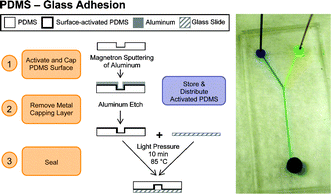Abstract
We describe a method for the irreversible bonding of PDMS-based microfluidic components by exploiting the first reported “shelfable” plasma treatment of PDMS. Simultaneous

* Corresponding authors
a
Department of Chemistry, The University of Western Ontario, 1151 Richmond Street, London, Canada
E-mail:
pnorton@uwo.ca
Fax: +1-(519)-661-3022
Tel: +1-(519)-661-2166
We describe a method for the irreversible bonding of PDMS-based microfluidic components by exploiting the first reported “shelfable” plasma treatment of PDMS. Simultaneous

 Please wait while we load your content...
Something went wrong. Try again?
Please wait while we load your content...
Something went wrong. Try again?
N. Patrito, J. M. McLachlan, S. N. Faria, J. Chan and P. R. Norton, Lab Chip, 2007, 7, 1813 DOI: 10.1039/B709761A
To request permission to reproduce material from this article, please go to the Copyright Clearance Center request page.
If you are an author contributing to an RSC publication, you do not need to request permission provided correct acknowledgement is given.
If you are the author of this article, you do not need to request permission to reproduce figures and diagrams provided correct acknowledgement is given. If you want to reproduce the whole article in a third-party publication (excluding your thesis/dissertation for which permission is not required) please go to the Copyright Clearance Center request page.
Read more about how to correctly acknowledge RSC content.
 Fetching data from CrossRef.
Fetching data from CrossRef.
This may take some time to load.
Loading related content
